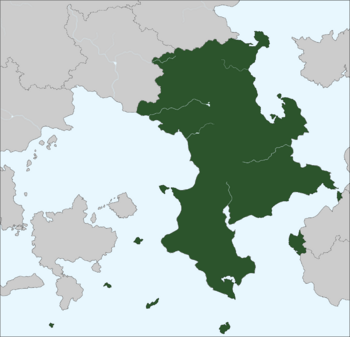Milenka
Commonwealth of Milenka Сполешенствиы Миленкй Spolešenestviū Milenkij | |
|---|---|
|
Flag | |
| Motto: Sapere Aude Dare to know | |
| Anthem: Калинин Брежен | |
 Political Map of Milenka, not including overseas territories | |
| Capital and largest city | Vladika |
| Official languages | Milenkan |
| Demonym(s) | Milenkan |
| Government | Federal parliamentary republic |
| Legislature | States General |
| Комора Слону | |
| Сейм | |
| Establishment | |
• First Imperial Dynasty | 284 BCE |
• Kingdom of Milenka | 1438 |
• Commonwealth | 1795 |
| Area | |
• | 3,220,092 km2 (1,243,284 sq mi) |
| Population | |
• 2015 census | 102,694,311 |
• Density | 31.9/km2 (82.6/sq mi) |
| GDP (PPP) | 2018 estimate |
• Total | $5,220 trillion |
• Per capita | $50,831 |
| GDP (nominal) | 2018 estimate |
• Total | $4,971 trillion |
• Per capita | $48,411 |
| Gini | 29.2 low |
| HDI (2015) | .914 very high |
| Currency | Denar (MLD) |
| Date format | dd.mm.yyyy |
| Driving side | right |
| ISO 3166 code | ML |
| Internet TLD | .ml |
Milenka (Milenkan: Миленка), officially the Commonwealth of Milenka (Milenka: Сполешенствиы Миленкй), Milenka is a country in the Eastern Lazarene Sea, lying between Conitia to the south and Nautasia to the east. It borders Erytheria to the west and Katranjiev and Lecia to the east.
Milenka includes 22 constituent states, 1 federal district and 1 principality, covering an area of 3,220,092 square kilometres, and has a largely subtropical climate. With 102 million inhabitants, it is the third most populous state of the Lazarene. Its capital is Vladika, while Svopristav serves as its financial capital and has the country's busiest airport. Milenka's largest urban area is the Matka conurbation, with its main centres of Vladika and Dana. The country's other major cities are Hrav, Tarshova, Ajka, Enichka, Jist, Maja, Detna, Belohrad, and Tobetsk.
Various slavic tribes have inhabited the northern parts of modern Milenka since the late bronze age. Archaeological artifacts indicate presence in the south of the Ostropev pensinula since 1600 BCE, organized in a collection of petty kingdoms and city states. Beginning in 212 BCE, Archon Milena founded what would be known as the Milenkan Empire upon the conquest of Svopristav, she and her dynasty expanding her realm and Tes Awri until 707, when the empire collapsed into several successor states. Milenka reunified in 1438 as the Kingdom of Milenka. In 1798, revolution toppled the monarchy and gave major democratic rights, founding the Commonwealth.
Today, the sovereign state of Milenka is a federal parliamentary republic led by a Chancellor. It is a lazarene power with a strong economy; with Esquarium's largest economy by nominal GDP. As a developed country with a very high standard of living, it upholds a social security and universal health care system, environmental protection, and a tuition-free university education.
The Commonwealth of Milenka is a member of the Lazarene Sea Association, having joined in 1968. It is also a founder of the Lazarene Common Market. Known for its rich cultural history, Milenka has been continuously the home of influential and successful artists, philosophers, musicians, film people, sportspeople, entrepreneurs, scientists, engineers, and inventors. Milenka has a large number of World Heritage sites and is among the top tourism destinations in the world.
Etymology
The word Milenka originates from a foreign naming of the Empire founded by Milena the Magnificent, later adapted to the local language. In the first generations of the Tanai dynasty, it was referred to by contemporary texts and historical sources simply as the Empire, with Milenka being adopted as a widespread term for the nation in the 1st century.
